7 Most Sought-After Front-End Frameworks for Web Developers
Examining the benefits and limitations of seven most demanding front-end frameworks for developers, which have been instrumental in the development of web applications.
Join the DZone community and get the full member experience.
Join For FreeFrontend frameworks are an essential tool for web development because they provide a structured and organized approach to building the user interface of a web application. They help developers create consistent and efficient layouts, styles, and interactions, making developing and maintaining a web application easier over time.
It allows your web apps to interact with APIs in the same way as any other program (on desktop OS, mobile device, or elsewhere). Moreover, front-end frameworks can improve the user experience as they keep the common parts of the page intact (like navigation, etc.) and load whatever data the user requests instead of flashing and reloading with every click.
In this article, you’ll learn about the most popular frontend frameworks and determine which is best suited for your website or web app. Alternatively, choosing the right front-end framework will help you save time and money.
7 Most Popular Front-End Frameworks
The most popular frontend frameworks include React, Angular, and Vue.js, with React being the most widely used at 42.62%.
1) React
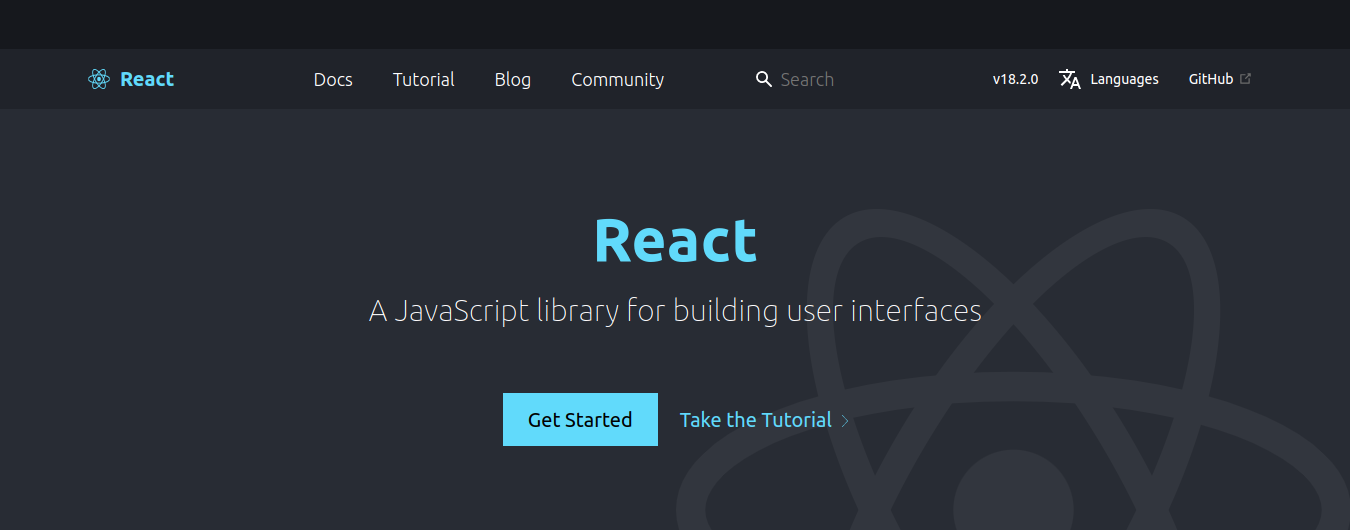
Jordan Walke developed ReactJS as an open-source frontend JavaScript library for creating structured user interfaces in web apps and websites. React allows developers to design extensive web applications that can update data without the need for a page reload. The primary objective of React is to provide a fast, scalable, and straightforward solution.
Since its release in May 2013, React has dominated the front-end development arena. According to reports, 75.4% of web development companies and agencies specialize in React, making it one of the most widely adopted frameworks.
React's popularity stems from its simplicity and versatility, which many firms consider to be the future of front-end development. It is used by around 10,499,785 active websites. Many major market players are adopting React development to grow their user base. Examples of React websites include GitHub, Facebook, Airbnb, Instagram, Salesforce, BBC, and Reddit, among others. These leading organizations utilizing React are a clear indication of its growing popularity and its position as a preferred frontend framework.
Benefits of React
- Performance and Speed — React enhances an application’s performance with features like virtual DOM. It helps in improving the speed of web applications by removing the heavy framework codes found in bootstrapping libraries like JQuery. React’s performance and speed are due to the Virtual DOM (Document Object Model). Developers can use it to design faster and more up-to-date applications. This is one of the topmost advantages of using React for the Front end.
- SEO-Friendly — Another advantage of React is its ability to deal with common problems with search engines. Mainly, these issues are unable to read JavaScript-heavy projects by search engines. It can operate on the server, render the virtual DOM, and return it to the browser as a regular webpage. The effective use of SEO improves the website and app’s ranking on Google search. Getting more users with organic traffic is the most important thing for any business looking for growth opportunities. React allows for simple SEO integration, which is a huge plus for any company. React is one of the most useful tools for building SEO-friendly web applications.
- Flexible — One of the most-liked benefits of React is flexibility. React code is very simple; it aids in maintaining the flexibility of web or mobile applications. Its flexibility saves a lot of time and money on app development. The major goal of this library is to make the app development process as simple as possible. As a result, React development has delivered notable results in web development.
- Strong Community Support — One of the most compelling reasons to use React for front-end development is its strong community support. React is continuously improving as an open-source library, thanks to a large community of developers who are helping people all over the world master the technology in various ways.
- Reusable Components — One of the key advantages of React is the ability to reuse components. Developers save time because they don’t have to write many codes for the same functionalities. Besides, any modifications made to one section of the application will have no effect on other portions of the application.
Limitations of Using React
- Initial learning can be difficult for developers to understand the concepts of JSX.
- React develops the UI part of the application. To get complete development tools, other technologies integration is required.
- The high speed of components upgrade makes it difficult to maintain proper documentation.
2) Angular
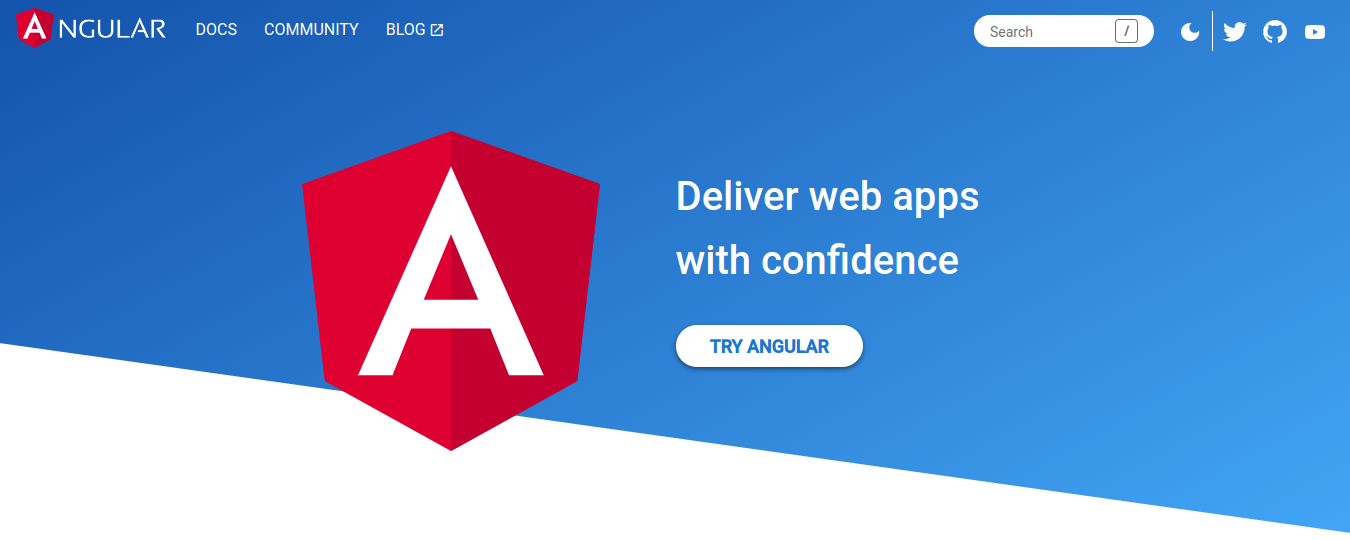
Angular, a front-end JavaScript framework is an open-source tool that enables developers to create interactive website components. Its main objective is to aid in the development of single-page applications, prioritizing code quality and testability. It is highly regarded as the "superhero" among JavaScript frameworks due to its exceptional performance, with over 1,016,104 live websites utilizing Angular.
Tech-giant Google is responsible for Angular's development, and major websites such as Paypal, Udemy, Snapchat, Amazon, Netflix, and Gmail rely on it. Angular provides abundant opportunities to create new and innovative projects regularly.
Angular is an excellent option for enterprise development, with a strong emphasis on code quality and testability, both of which are critical components of web development.
Benefits of Angular
- Two-Way Binding — This framework enables modeling and view synchronization in real time. As a result, it is simple for developers to make modifications during the development process. Any changes to the data get reflected in the view. Two-way binding makes programming easier and eliminates the need for a testability controller. Angular developers can easily and quickly develop a variety of applications.
- POJO Model — The Plain Old JavaScript Objects (POJO) Model is used by Angular to make the code structure scalable and independent. This way, we avoid having to introduce complex functions or methods to the program. It also eliminates the need for third-party frameworks or plugins. Apps built with Angular load quickly and give outstanding user accessibility; the model allows us to keep our codes clean, making the framework goal-oriented.
- Security — RESTFUL APIs are utilized to interact with servers in Angular for web app development. This would safeguard your web application from malicious attacks. As a result, Angular development will provide you with complete peace of mind.
- Single Page Applications (SPA) — The concept of SPA is used in almost all modern applications. As SPA loads a single HTML page and updates only a part of the page with each mouse click. During the procedure, the page does not reload or transfer control to another page. This guarantees good performance and faster page loading.
- Great MVC — MVC architecture also assists in the development of apps that are simple to use, adaptable, and dynamic in nature. Additionally, Angular gets closer to the MVVM architecture (Model-View-View-Model), building a stable platform for application development.
Limitations of Using Angular
- A wide variety of intricate built-in features make Angular complex to learn and implement.
- The possible lag in dynamic applications can hinder the satisfactory performance of the framework.
- New developers for small-scale web application development can find it difficult to implement.
3) Vue.JS

Vue.JS is a JavaScript framework designed for building modern application user interfaces with minimal resource requirements. Currently, there are 1,940,742 active websites utilizing Vue.JS, including major sites like Louis Vuitton, Adobe, BMW, Upwork, Alibaba, Gitlab, and Xiaomi.
Vue.JS is primarily focused on the view layer, enabling easy integration into existing projects, and is ideal for building single-page applications. Its popularity stems from several factors, including its ability to re-render without user input, its support for creating reusable and robust components, and its composable nature, allowing for the addition of components as needed.
With Vue.JS, developers have access to a comprehensive set of tools that simplify the development process. The framework is also highly adaptable, lightweight, and modular, featuring smart state management and routing options.
Additionally, Vue.JS enables rapid development with the help of numerous plugins that offer cost-effective solutions to common application problems. Overall, Vue.JS is a versatile and powerful framework that can facilitate the fast and efficient development of high-quality applications.
Benefits of Vue.JS
- Component-Based Architecture — Vue.JS is a component-based framework; the entire code for the frontend application can be divided into separate components. The components consisting of templates, logic, and styles are bound together to form a web app. Vue.JS components are lightweight, reusable, and simple to test.
- Lightweight — Vue.JS is only 18-21kb in size. It is up to 4x less than a minified jQuery. It reduces load time and helps in optimizing search engines and performance.
- Easy Integration — Vue.JS supports many third-party libraries and components. This makes it easy for developers to integrate Vue.JS into their existing projects. This saves a significant amount of time for companies who are attempting to stay on top of industry developments.
- Progressive — Vue.JS framework is precisely progressive. It is gradually adopted in small steps and adds more markup to the HTML code. Consequently, it changes as per the needs of developers and does not require rewriting an existing application. Vue.JS is a basic script tag that you can insert into your HTML code. It gradually expands as per your needs until it can manage the entire layer.
- Detailed Documentation — Vue.JS has well-defined documentation that allows you to easily comprehend the required method and develop your application. Additionally, it provides one of the best API references in the business. Vue.JS documentation is regularly updated. Good documentation is essential when using a new framework. Detailed documentation makes the technology easy to use, and you’ll be able to fix bugs effectively.
Limitations of Using Vue.JS
- Vue is still in its growing stage to have a large community.
- It does not provide a comparative variety of features as compared to frameworks like Angular or React.
- Built-in documentation in the Chinese language creates a significant language barrier for people out of China.
4) Svelte

Svelte is a novel technology for building web applications that comprise components, tools, and guidelines for constructing your website's architecture using JavaScript.
One of the distinguishing features of Svelte is that it does not rely on virtual DOM, setting it apart from other front-end frameworks. This characteristic enhances coding efficiency right from the start, resulting in a lighter, more user-friendly website or application.
Rich Harris created Svelte in 2016, and it has since gained a devoted following, with 71.4% of users appreciating its remarkable front-end development capabilities.
Benefits of Svelte
- Easy to understand components — Svelte is a clear and neat framework with no unnecessary additions. It has components that make the coding and designing process much easier.
- Out-of-the-box global state management — Svelte doesn’t need some complicated third-party state management tools; rather, it simply defines a variable as a writeable/ readable store and uses that in all .svelte files preceded by a $ sign.
- Default style setting — Svelte styles are extended by default. Here, the svelte-class name is attached to your styles to not leak and influence the style of other components. This significantly speeds up the entire design process.
- Built-in effects and animations — Animation usually requires an external dependency to handle it. However, Svelte provides some pre-packed powerful effect modules like motion, transition, animation, and easing effects.
- Built-in Accessibility — Svelte displays an “A11y: element should have an alt attribute” reminder whenever you forget to put the alt attribute on a tag.
Limitations of Using Svelte
- Using special syntax instead of directly using onClick, like in React, can be frustrating.
- No support for reference updates and array mutations.
- Svelte doesn’t support a wide range of plugins and integrations required for heavy production apps.
5) Next.JS
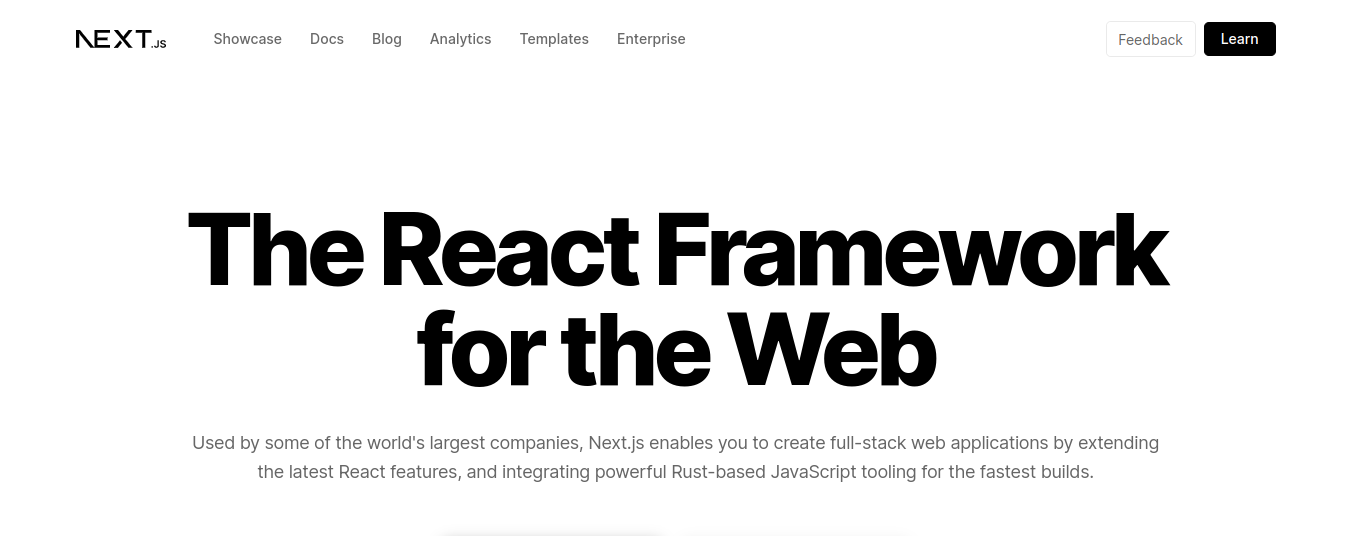
In 2016, Vercel CEO Guillermo Raunch created Next.JS, an open-source JavaScript framework that allows for the development of highly user-friendly and fast websites. This frontend framework is known for its clarity and can be used to create hybrid apps through Automatic Static Optimization, which combines dynamic and static attributes. Next.JS renders both the server side and client side through Universal Apps, making it a great tool for building single-page applications.
Next.JS is also highly regarded for its improved search engine optimization (SEO) benefits, which is a boon for marketers. Popular websites such as Hashnode, AT&T, TikTok, and Twitch use Next.JS for their front-end development.
Benefits of Next.JS
- Better SEO — Opting for SSR instead of client-rendered JavaScript helps in making your website visible considerably for search engines. This provides a better competitive edge for your business.
- Enhanced performance — Ideally, users value a website that loads faster without consuming their valuable time. Next.JS enhances the loading speed and helps to keep your website visitors engaged with better UX.
- Easy upgrades — The upgrade takes lesser time and is without any complex procedures. This convenience makes it encouraging to take the development experience to the next level.
- Automated code splitting — Next.JS has a code split on each page. This becomes a great advantage because even after growing the application with more and more pages, the bundle size doesn’t increase.
- Image optimization — The powerful native API automatically optimizes images with its built-in components. This not only improves developers’ convenience but also refines the user experience of your website.
Limitations of Using Next.JS
- A limited set of adaptable plugins makes it challenging to manage the application.
- It requires integrating state management tools like MobX or Redux.
- Next.JS lacks built-in frontend pages and thus requires creating the entire front end diligently.
6) jQuery
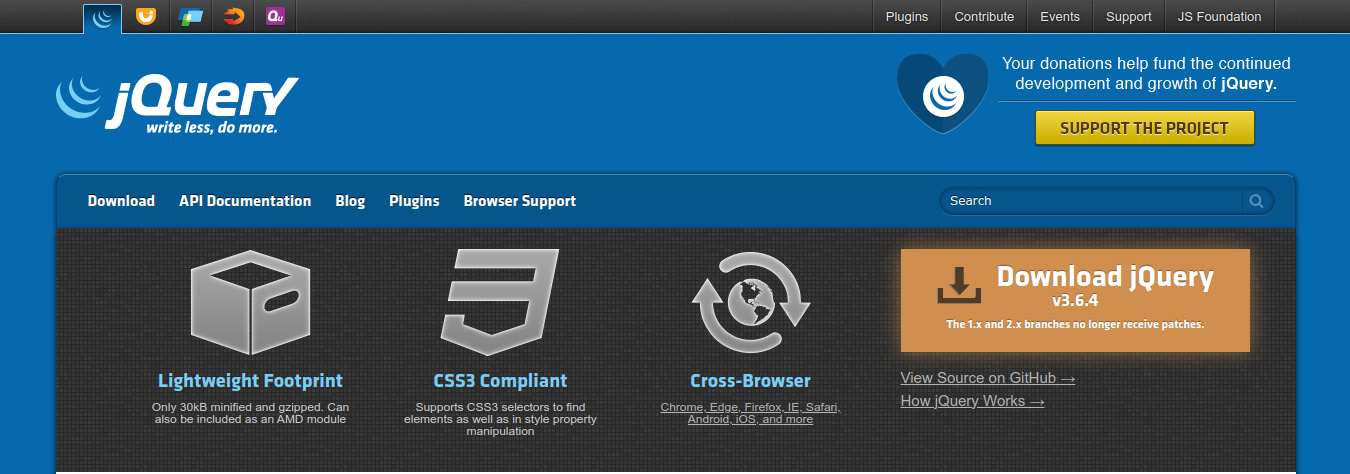
Introduced in 2006, jQuery remains a popular frontend framework for website development despite its early establishment. Its longevity has given rise to a sizable community for obtaining solutions.
Considered one of the best front-end JavaScript frameworks, jQuery is small, simple, feature-rich, and easy to use. It simplifies complicated tasks such as AJAX and DOM manipulation by wrapping them in a single line of code.
The jQuery library is packed with brilliant features, including HTML/DOM manipulation, CSS manipulation, HTML event methods, effects and animations, AJAX, and other utilities. Furthermore, there are plugins available for nearly any task.
Well-known companies such as Google, Microsoft, IBM, and Netflix, along with 41 million other websites, utilize jQuery.
Benefits of jQuery
- Popularity — It is incredibly famous, with a large community of users and considerable contributors participating as developers and campaigners.
- Cross-browser support — jQuery is compatible with popular web browsers, including CSS3 selectors and XML Path Language syntax too.
- Animation Function — CSS properties allow animating elements and even let you adjust the animation duration with transition mode.
- HTML modifications — It helps in the easier selection of DOM elements to transverse and modify the content for generating custom settings.
- Lightweight — The minified size of the library is about 19 KB in size.
Limitations of Using jQuery
- Relatively slow working speed
- Obsolete APIs of the document object model
- Not convenient to use it for large-scale production
7) Backbone.JS
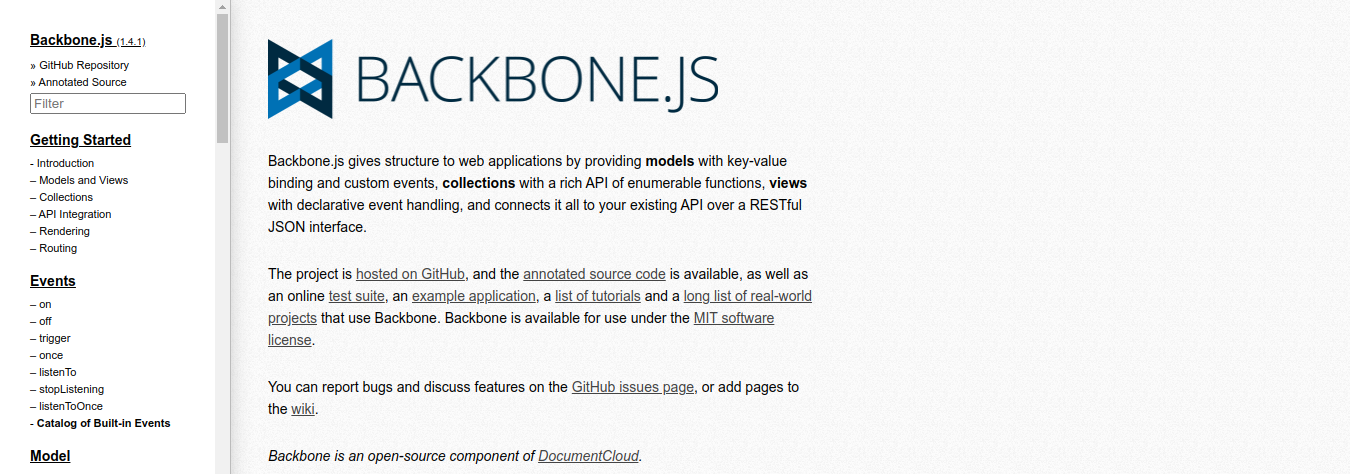
In 2010, Jeremy Ashkenas created Backbone.JS, an open-source JavaScript frontend framework. Its main purpose is to provide structure to web applications through key-value binding and custom events for models. Additionally, Backbone.JS includes a Router that's useful in developing single-page applications.
Backbone.JS is particularly suited for creating client-rich applications that consume REST APIs. It simplifies the process by retrieving all the necessary codes (HTML, CSS, and JavaScript) with a single page load, resulting in a smooth and enjoyable user experience.
GitHub hosts Backbone.JS, and it offers an online suite, tutorials, and a list of real-world projects that employ it. Some of the companies that use Backbone.JS include Uber, Pinterest, Reddit, and Walmart.
Benefits of Backbone.JS
- Event-driven communication — Backbone.JS alleviates code cluttering that is, either way, difficult to read. The events are built on top of regular DOM events, which makes the mechanism quite extensible and versatile.
- Maintainability via Conventions — Backbone.JS maintains clean code in spite of having multiple people coordinating on a code. Here, conventions introduce a common coding style that mandates no need for an extensive set of coding standards.
- Attune with back-end — Backbone.JS provides great support to REST APIs. The correctly designed APIs are configured by the framework for direct access to read, write, and delete operations via GET, POST, and DELETE.
- Simplicity and Flexibility — Backbone.JS requires only a few minutes to get started, even while using high-level additional libraries like Chaplin.
- Vast Ecosystem — With large community support, Backbone.JS provides a lot of plugins and extensions. It also has cogent documentation with solutions for most of the problems.
Limitations of using Backbone.JS
- Easy smaller updates to DOM for large data structures can lead to poor UX.
- Unit testing with Backbone.JS is quite a complicated challenge.
- Lack of controller building block.
Conclusion
Ultimately, the best front-end framework for a project will depend on the specific needs and goals of the project, as well as the preferences and experience of the development team. It is important to carefully evaluate the available options and choose a framework that will best support the project’s needs.
When selecting a front-end framework for your web development project, it is important to consider a variety of characteristics. These include ensuring that the framework is secure, focused on delivering user-driven outcomes, capable of improving performance, optimized for navigation, capable of retaining visitors, and effectively communicates the business intent. Additionally, there may be other important characteristics to keep in mind as well.
Published at DZone with permission of Neha Rajvanshi. See the original article here.
Opinions expressed by DZone contributors are their own.

Comments